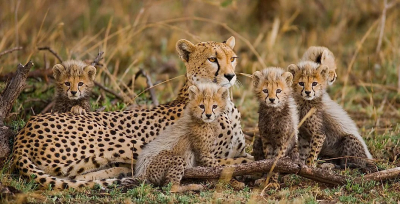
When the Indian government brought the big cat to India last September, there was palpable excitement. However, in a matter of months, at least three adults – and a few cubs born in India – have died, turning the focus once again on the viability of such an ambitious project. In five points, here's a quick look at all that's been happening
- Cheetah goes extinct
India has been a proud host to several big cat species, including the Asiatic lion, the Bengal tiger, and the snow leopard. More than seven decades earlier, it was also home to the Asiatic cheetah, found in the wild today only in Iran. Plagued by hunting habitat loss, and reduction in prey base, their numbers plunged dramatically over the years; the last of this carnivore died way back in 1947. Five years later it was declared officially extinct in our country – "the only large mammal to become extinct since independence".
- Bringing the big cat home
For decades, India had considered bringing the Asiatic cheetah from Iran. However, since Iran itself was host to only a small number of this animal, India could not move ahead with that plan. (Today, the number of Asiatic cheetahs in Iran stands at a paltry 12: the country recently lost a 10-month-old cub born in captivity.) Meanwhile, the idea of 'African Cheetah Introduction Project in India' shaped up in 2009, but it failed to take off for over a decade. When it appeared as if it could come to fruition after 2019, the COVID-19 pandemic set in, delaying it further. The wait finally ended in 2022, when the world's fastest land animal came to our country.
- The reintroduction begins
With great fanfare, as many as eight cheetahs arrived from Namibia last September. A few months later, 12 more arrived from South Africa. (It is said that the plan is to bring a total of 50 in the next five to 10 years.) They reached an enclosure at Kuno National Park in Madhya Pradesh. Since they arrived from a different country (and even a continent), they need time for acclimatisation (getting used to their new surroundings). So, gradually over a period of time they are to be released into the wild from their enclosures. But, it seems, not all 20 will survive the relocation.
- Births and deaths
In March, a female cheetah brought in from Namibia died, possibly due to kidney ailment. That would be the first of a few more deaths to follow. In April, a male, belonging to the batch from South Africa, died, due to cardiac failure. In May, a female cheetah from South Africa died, believed to be from injuries during mating. Meanwhile, just a couple of days after the death of the first cheetah, a female from Namibia gave birth to four cubs. But that joy was to be short-lived – in May, at least three of them died due to reasons such as weakness and dehydration.
- Hope and reality
The government and the supporters of the project have hoped the reintroduction is a chance to restore the biodiversity link that was broken due to the animal's extinction. Viewing it as a step towards wildlife education and conservation awareness, they also believe that the species can revive the grasslands it once roamed. However, many conservationists and critics have all along said that the project is unviable due to several reasons. One of them is that Kuno has neither enough space nor prey for the big cat. In fact, following the deaths of the cheetahs, the Supreme Court itself has come down heavily on the government, urging it to home some of these carnivores in other States, including Rajasthan. While stating that such deaths are not unusual, the government has said it would explore other places for the animal's release into the wild.
Picture Credit : Google




